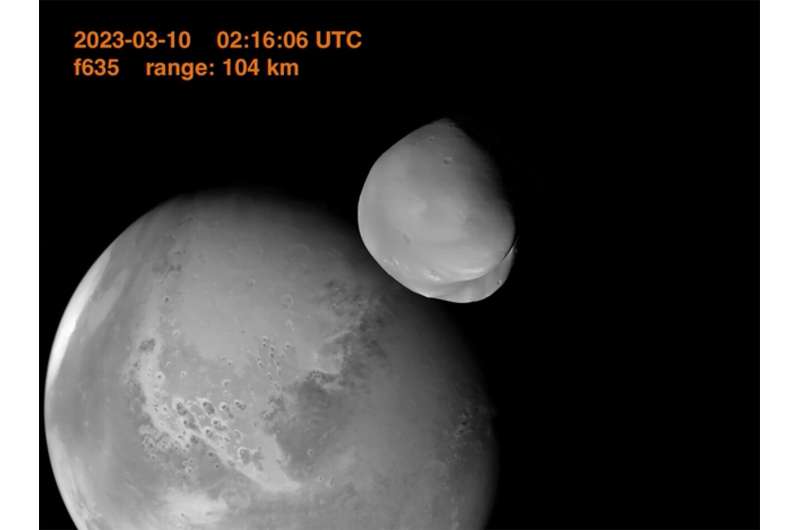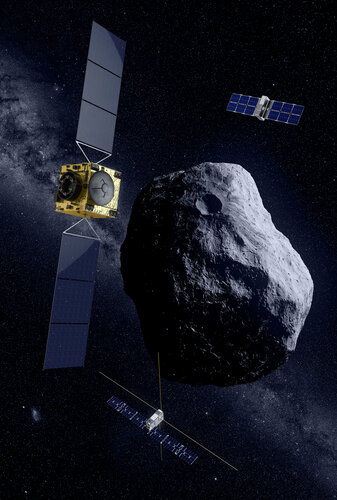UAE spacecraft takes close-up photos of Mars' little moon
Monday, 24 April 2023 16:07
A spacecraft around Mars has sent back the most detailed photos yet of the red planet's little moon.
The United Arab Emirates' Amal spacecraft flew within 62 miles (100 kilometers) of Deimos last month and the close-up shots were released Monday. Amal—Arabic for Hope—got a two-for-one when Mars photobombed some of the images.
Inmarsat Q&A | Mobile satellite services coming back stronger than a ‘90s trend
Monday, 24 April 2023 15:06
SpaceNews interviewed Peter Hardinger, Inmarsat’s chief technology officer, about how the operator plans to take advantage of emerging direct-to-smartphone capabilities that are breathing new life into the mobile satellite services industry.
Webb reveals primordial galaxy cluster 650 million years after the Big Bang
Monday, 24 April 2023 13:54 Every giant was once a baby, though you may never have seen them at that stage of their development. NASA's James Webb Space Telescope has begun to shed light on formative years in the history of the universe that have thus far been beyond reach: the formation and assembly of galaxies. For the first time, a protocluster of seven galaxies has been confirmed at a distance that astronomers refer to
Every giant was once a baby, though you may never have seen them at that stage of their development. NASA's James Webb Space Telescope has begun to shed light on formative years in the history of the universe that have thus far been beyond reach: the formation and assembly of galaxies. For the first time, a protocluster of seven galaxies has been confirmed at a distance that astronomers refer to Potential Failure Modes of SpaceX's Starship
Monday, 24 April 2023 13:54 On April 20, 2023, a little after 9:30 A.M. eastern time SpaceX's new Starship system lifted off from the company's southeast Texas spaceport. This was an historic event because the Starship is the largest and most powerful rocket ever built. The ship ascended smoothly for the first several minutes, but as the vehicle approached the moment of stage separation an anomaly occurred that resulted in
On April 20, 2023, a little after 9:30 A.M. eastern time SpaceX's new Starship system lifted off from the company's southeast Texas spaceport. This was an historic event because the Starship is the largest and most powerful rocket ever built. The ship ascended smoothly for the first several minutes, but as the vehicle approached the moment of stage separation an anomaly occurred that resulted in Starship moves fast and breaks things
Monday, 24 April 2023 13:54 Flying chunks of concrete, twisted metal sheets, craters blasted deep into the ground: the thunderous power of SpaceX's first test flight of Starship - the biggest and most powerful rocket ever built - inflicted serious damage on its Texas launch site.
Repairing the damage from Thursday's unmanned test flight is expected to take months, potentially delaying further launch attempts and slow
Flying chunks of concrete, twisted metal sheets, craters blasted deep into the ground: the thunderous power of SpaceX's first test flight of Starship - the biggest and most powerful rocket ever built - inflicted serious damage on its Texas launch site.
Repairing the damage from Thursday's unmanned test flight is expected to take months, potentially delaying further launch attempts and slow Defying gravity
Monday, 24 April 2023 13:54 Surely it has ever happened to you to shake an open bag of mixed nuts. Have you noticed that after such a procedure, the largest nuts in the mixture - Brazil nuts - float to the top? The phenomenon of large objects rising to the surface of a mixture of small objects, bearing the professional name of granular convection, is popularly referred to "the Brazil nut effect" and occurs commonly in natu
Surely it has ever happened to you to shake an open bag of mixed nuts. Have you noticed that after such a procedure, the largest nuts in the mixture - Brazil nuts - float to the top? The phenomenon of large objects rising to the surface of a mixture of small objects, bearing the professional name of granular convection, is popularly referred to "the Brazil nut effect" and occurs commonly in natu Webb reveals early-Universe prequel to huge galaxy cluster
Monday, 24 April 2023 13:00 Image:
Image:
The seven galaxies highlighted in this image from the NASA/ESA/CSA Telescope have been confirmed to be at a distance that astronomers refer to as redshift 7.9, which correlates to 650 million years after the big bang. This makes them the earliest galaxies yet to be spectroscopically confirmed as part of a developing cluster.
The seven galaxies confirmed by Webb were first established as candidates for observation using data from the NASA/ESA Hubble Space Telescope’s Frontier Fields program. The program dedicated Hubble time to observations using gravitational lensing, to observe very distant galaxies in detail. However, because Hubble cannot detect light
Maxar eyes summer launch of WorldView Legion imaging satellites
Monday, 24 April 2023 12:30
After years of delays, Maxar Technologies is preparing for the first launch this summer of its next-generation imaging satellites WorldView Legion.
What colour is an asteroid? Hyperspectral imager to find out
Monday, 24 April 2023 12:30
What colour is an asteroid? The latest instrument being prepared for ESA’s Hera mission for planetary defence will observe its target Dimorphos asteroid in a range of colours far beyond the limits of the human eye. In the process Hera’s HyperScout H hyperspectral imager will help prospect the asteroid’s mineral makeup – in the process helping to deduce how best to deflect future asteroids which might one day endanger Earth.
CAPSTONE Demonstrates Crosslink Capability with Lunar Reconnaissance Orbiter
Monday, 24 April 2023 06:57 The CAPSTONE mission team has provided an update on the spacecraft's operations since performing the Near Rectilinear Halo Orbit (NRHO) insertion maneuver on November 13th, 2022. The spacecraft has spent 154 days operating in the NRHO, completing 23 NRHO revolutions, and executing six Orbit Maintenance Maneuvers (OMM) using approximately 1.8 m/s of fuel.
Despite issues with a thruster valv
The CAPSTONE mission team has provided an update on the spacecraft's operations since performing the Near Rectilinear Halo Orbit (NRHO) insertion maneuver on November 13th, 2022. The spacecraft has spent 154 days operating in the NRHO, completing 23 NRHO revolutions, and executing six Orbit Maintenance Maneuvers (OMM) using approximately 1.8 m/s of fuel.
Despite issues with a thruster valv A staunch supporter of China's space undertakings
Monday, 24 April 2023 06:57 President Xi Jinping has been a staunch supporter of China's space undertakings. He has paid visits to several space launch sites and he frequently mentioned the country's space achievements in his New Year addresses.
Xi has a deep impression and high opinion of Dongfanghong-1, China's first man-made satellite launched in 1970. In a letter replying to veteran scientists in April 2020, Xi r
President Xi Jinping has been a staunch supporter of China's space undertakings. He has paid visits to several space launch sites and he frequently mentioned the country's space achievements in his New Year addresses.
Xi has a deep impression and high opinion of Dongfanghong-1, China's first man-made satellite launched in 1970. In a letter replying to veteran scientists in April 2020, Xi r Open cooperation, China Aerospace goes to the world
Monday, 24 April 2023 06:57 On November 21, 2022, President Xi Jinping pointed out in his congratulatory letter to the United Nations/China Space Exploration and Innovation Global Partnership Symposium that there is no end to space exploration. China is willing to work with other countries to strengthen exchanges and cooperation, jointly explore the mysteries of the universe, use outer space peacefully, and promote space t
On November 21, 2022, President Xi Jinping pointed out in his congratulatory letter to the United Nations/China Space Exploration and Innovation Global Partnership Symposium that there is no end to space exploration. China is willing to work with other countries to strengthen exchanges and cooperation, jointly explore the mysteries of the universe, use outer space peacefully, and promote space t Five ways open science is transforming NASA research and protecting our planet
Monday, 24 April 2023 06:57 In celebration of Earth Day, it's important to recognize the role of open science in protecting our planet and advancing NASA's research efforts. Through initiatives like NASA's Transform to Open Science (TOPS), researchers can collaborate and share data, promoting transparency and scientific integrity.
By sharing research findings and data publicly, NASA is enabling scientists and the pub
In celebration of Earth Day, it's important to recognize the role of open science in protecting our planet and advancing NASA's research efforts. Through initiatives like NASA's Transform to Open Science (TOPS), researchers can collaborate and share data, promoting transparency and scientific integrity.
By sharing research findings and data publicly, NASA is enabling scientists and the pub China's space missions break new ground
Monday, 24 April 2023 06:57 Lunar samples, mineral discovery and experience for future missions among gains Chinese scientists have made major advances in the research of Earth's nearest celestial neighbor, the moon, thanks to samples and data gathered by China's lunar probes.
In the latest development, water locked in glass beads has been found in lunar samples returned by the Chang'e 5 mission.
A study publis
Lunar samples, mineral discovery and experience for future missions among gains Chinese scientists have made major advances in the research of Earth's nearest celestial neighbor, the moon, thanks to samples and data gathered by China's lunar probes.
In the latest development, water locked in glass beads has been found in lunar samples returned by the Chang'e 5 mission.
A study publis Giant SpaceX rocket leaves crater, serious damage at Texas base
Monday, 24 April 2023 01:20 Flying chunks of concrete, twisted metal sheets, craters blasted deep into the ground: the thunderous power of SpaceX's first test flight of Starship - the biggest and most powerful rocket ever built - inflicted serious damage on its Texas launch site.
Repairing the damage from Thursday's unmanned test flight is expected to take months, potentially delaying further launch attempts and slow
Flying chunks of concrete, twisted metal sheets, craters blasted deep into the ground: the thunderous power of SpaceX's first test flight of Starship - the biggest and most powerful rocket ever built - inflicted serious damage on its Texas launch site.
Repairing the damage from Thursday's unmanned test flight is expected to take months, potentially delaying further launch attempts and slow 
